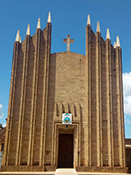Introduction and Background of Meru Diocese
Meru Diocese covers two counties namely Meru and TharakaNithi. It comprisesthe larger Meru that has 12 sub counties/constituencies. It was founded on March 10, 1926 as the Prefecture Apostolic of Meru. It was elevated to the Diocese of Meru on May 7, 1953 as a suffrage of the Archdiocese of Nyeri. The diocese covers the area that is home to the people of the larger Meru who live around the eastern slopes of Mount Kenya.
The Ameru live within rugged hills with land that ranges from heavy virgin forests above 8,000 feet elevation to semi-arid desert at less than 3,000 feet elevation. They are generally part of the “Eastern Bantu” who have been native to the Mt. Kenya area for many years before colonization of Kenya by Great Britain in the 19th Century. The people of Meru are now predominantly Christians. The majority of Meru people are subsistence farmers. The fertile land produces a large variety of food crops, the staples being corn, beans, potatoes, sorghum and millet. Coffee is the most important cash crop followed by tea, miraa, cotton, bananas and other assorted fruits. The Catholic faith was brought to Meru by the Consolata Missionaries from Turin – Italy in 1911.
They first settled at Kithitu near Kariakomo in Mwimbi Location and at Kiija near Mujwa in Imenti. By the decree of the Holy See, Meru was split from Nyeri and was made an Apostolic Prefecture on March 10, 1926. Up to the outbreak of the World War 2 between 1936 and 1945, there were 8 Mission Stations namely: Mujwa (Imenti), Igoji, Chuka, Kyeni (Embu), Tigania, Tuuru, Amung’enti and Mikinduriwith resident priests.
On 2nd May 1953, the Prefecture of Meru was created into the Diocese of Meru with Mons. Bessone Lorenzo as its first Bishop in 1954. Bishop Bessone died on 7th April, 1976 and Mons. Silas S. Njiru was elected as the second and the first African Bishop of Meru on 9th December, 1976. In 1976 Garissa prefecture – now Diocese of Garissa – was created from the Diocese of Meru, and ten years later, on 28th June 1986, His Holiness Pope John II created the new Diocese of Embu from the Diocese of Meru, under Bishop John Njue of the Diocesan Clergy of Meru, leaving the Diocese of Meru with Meru and Isiolo Districts. On 15th December 1995, His holiness Pope John Paul II created Isiolo Apostolic Vicariate under Mons. Luigi Locati. The Diocese was left with the larger Meru as its area of jurisdiction. On the retirement of Bishop Silas S. Njiru, Bishop Salesius Mugambi was appointed the 2nd African Bishop in 2004 after serving as a Coadjutor Bishop for two years.
The diocese which borders Isiolo to the North, Kitui to the East, Embu to the South and Nyeri to the West is made up of eight deaneries namely: from North to South and then East to West: Igembe, Tigania, Buuri, Imenti North, Imenti Central, South Imenti, Meru South and Tharaka.
